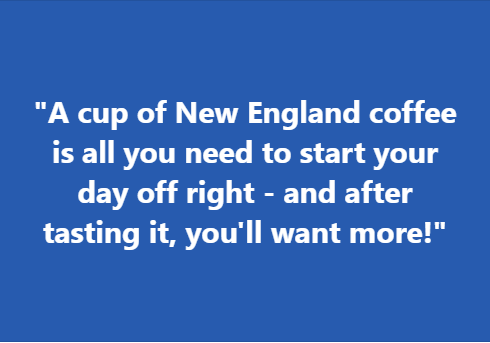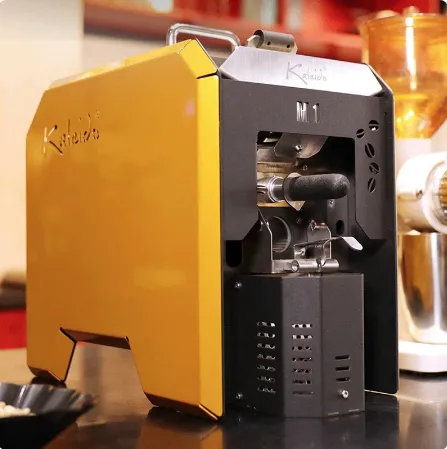New England Coffee Review: After We Tasted. As coffee lovers, we have always enjoyed the aroma and flavors of locally brewed coffees.
Table of Contents
Our team has tasted and evaluated numerous brands of New England coffee in order to bring you an honest and comprehensive review of each variety.
We have taken into account all aspects of taste, aroma, price, origin, and more to provide you with an unbiased review of each coffee featured in our guide.
New England Coffee Review: After We Tasted offers a series of reviews and ratings for coffees from the New England region.
New England Coffee Review
The reviews focus on coffees purchased at local shops and those available online.
For each coffee, they give a rating based on flavor profile, aroma, body and acidity levels, complexity, and overall balance.
They also provide tasting notes to help readers choose the right coffee for their needs.
In addition to offering objective reviews, the website provides an extensive guide to understanding coffee brewing techniques and equipment.
They offer advice about grind sizes, water temperature settings, and other aspects that can affect the final cup of coffee.
Finally, they also have a section dedicated to showcasing new products from roasters in the area so that readers can stay up-to-date with what’s trending in New England coffees.
Roast Types: Light, Medium, Dark
Light roast coffee beans are roasted for the shortest amount of time and produce a brew with a light-bodied flavor. The lightest roasts are more acidic and offer bright, fruity notes.
It’s important to note that the amount of caffeine in a cup of coffee isn’t determined by the roast type, but rather by the bean itself.
Medium-roast coffee beans are roasted for longer than light roasts and produce a medium-bodied cup with balanced acidity and body.
They tend to have more complexity compared to lighter roasts while still maintaining some of the unique characteristics found in each individual bean variety.
Dark roast coffee beans are roasted for an extended period which creates a rich and robust flavor profile that is often described as bittersweet or smoky.
Darker roasts can mask some of the finer nuances found in certain coffees but offer bold flavors making them popular for use in espresso blends or other intense drinks like Turkish Coffee preparation methods.
Brewing Method: French Press vs. Drip
The French press and drip brewing methods differ in several ways. The French press uses a metal mesh filter to steep the grounds directly in the pot, while drip brewers use a paper or cloth filter, which traps finer particles than the French press.
This results in a cup of coffee with much more body and texture when brewed with a French press.
Additionally, because you don’t have to replace filters every time you brew, using a French press is often more cost-efficient than using a drip brewer.
In terms of preparation time, the French press requires roughly four minutes for an 8-ounce cup of coffee whereas most automatic drip machines take about 5 minutes.
The most significant difference between these two methods is that the plunger on the
French Press does not completely separate all of the grounds from your brewed cup of coffee whereas most automated drip machines will extract all of their flavors from the freshly ground beans before they are dispensed into your mug or carafe.
With manual brewing methods such as pour-over and aeropress, there is less mess and less waste, but with French press it can be difficult to get all of those pesky grounds out after each use, making it more labor intensive at times.
Aroma & Taste: Notes and Mouthfeel
Aroma and taste are two important factors when it comes to coffee tasting. The notes of the coffee can range from nutty, earthy, floral, and more depending on where the beans were sourced from and how they were processed.
Additionally, the mouthfeel of a cup of coffee can be described as creamy, smooth, silky, or even crunchy.
It’s important for those in the specialty coffee industry to be able to recognize these characteristics for each type of bean so that they know what to expect when brewing a cup.
In addition to recognizing individual notes and mouthfeel in a single-origin variety of coffee beans, it is also wise to have an understanding of how different roasts will affect flavor profiles.
For example, light roasts are often fruity and acidic while dark roasts tend to be smoky with a thick body.
Knowing this information allows baristas or consumers who like certain flavors in their cups to make sure they get exactly what they want by choosing their roast accordingly.
Lastly, aroma plays an important role in overall experience; it’s one of the first senses we use when evaluating something new.
Aromas such as chocolate or berry can evoke pleasant memories and add an extra layer of complexity when tasting a cup for the first time.
Paying attention to both aroma and taste together will help you better understand your own preferences so you can continue enjoying your favorite coffees!
Quality Assurance: Sourcing and Testing
Sourcing quality beans can be a challenge, but it’s worth the effort. When sourcing beans, it’s important to focus on finding suppliers who are committed to sustainable practices, as well as those with high-grade quality and flavor.
Additionally, when evaluating potential suppliers, researching their commitment to sustainable production is key; look for certifications such as Fair Trade Certified or Rainforest Alliance Certified.
Testing the beans is an essential part of ensuring consistency in flavor and quality across batches.
For example, when tasting coffees from Ethiopia or Kenya, tasters should pay attention to notes like lemon or blueberry that may be present in the cup.
It’s also important to consider variables like brewing time and water temperature when testing coffee since these factors can alter the nuances of coffee flavors significantly.
Finally, consider tracking any changes made during testing so that if necessary you can replicate results later on if needed.
Cost & Availability: Pricing and Locations
Pricing for New England Coffee varies depending on the size and type of bag purchased.
Ground coffee is offered in 12-ounce, 24-ounce, and 32-ounce packages with prices ranging from $9-$17.
Whole bean coffee is available in 8-ounce and 16-ounce bags with prices between $8-$15. K-Cup pods are also sold in 12-count boxes with prices around $11 per box.
The cost of shipping will depend on the size of your order and the method chosen.
New England Coffee can be found at many retail locations throughout the United States, including grocery stores, convenience stores, and online retailers such as Amazon.
Additionally, their products are available in select international markets such as Canada and Japan.
Customers can easily locate a store or retailer carrying New England Coffee by using their Store Locator tool on their website or mobile app.
Conclusion: The Final Verdict
In the end, it’s clear that New England Coffee is a superior choice for those looking for a great cup of coffee.
The flavor profile is smooth and rich, with just the right amount of acidity and sweetness to create an incredibly satisfying cup of coffee.
Additionally, the aroma is strong and inviting, making it an ideal choice to start your day with.
Furthermore, New England Coffee offers its blends in different roasts so that you can find one that best suits your taste preferences.
Finally, the company stands behind its product by offering a satisfaction guarantee on all of its purchases.
All in all, New England Coffee has earned our highest recommendation for those looking for a great-tasting coffee experience.






